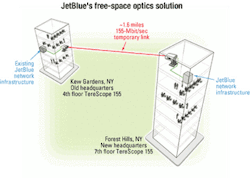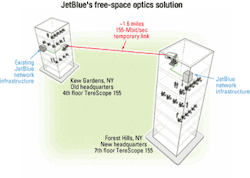JetBlue Airways catches glimpse of 'invisible' optics
JetBlue Airways (Forrest Hills, NY), a four-year-old air carrier building a reputation for innovation and the use of new technologies, put free-space optics (FSO) to the test in solving the problem of relocating its corporate headquarters without suffering a significant loss in communications. Getting high-speed communications installed and running in a timely fashion was a major hurdle, but the ability to quickly install a temporary network link between the old and new headquarters made an FSO solution a solid contender for the task.
FSO technology involves transmitting high bandwidth over the air between two points using invisible beams of light instead of radio spectrum. This solution affords fiber-like speeds without the fiber. The distances are relatively short, but with only 1.6 mi separating JetBlue's old and new facilities, FSO was a viable option.
JetBlue, along with networking partner Manchester Technologies (Long Island, NY), considered several other options, including a dedicated T3 (44.736-Mbit/sec) link or the use of wireless radio frequency (RF). "A T3 facility was quoted as costing $8,000 a month," says Brian Hansen, sales manager at Manchester Technologies. "The delay in deployment and the additional multiplexers and routers were obstacles against using a T3."
Using RF wireless technology raised even more issues since it can only provide relatively low bandwidth and transmission rates, not to mention requiring licensing for deployment. But the biggest problem with RF wireless was its risk in terms of security. "Radio or microwave links, while workable, tend to run at lower speeds and have substantial divergence issues associated with the propagation of the signal," says Hansen. "Even a supposed line of sight microwave signal can spread out to over 1,500 ft across a 1-km link. This divergence multiplies the possibility that the signal could be tapped for criminal purposes."
JetBlue network services director Tony Mitsching ultimately decided to proceed with the FSO solution, choosing the TereScope 155, an infrared laser-based system manufactured by MRV Communications (Chatsworth, CA). The TereScope 155 supports data rates ranging from 10 to 155 Mbits/sec at distances up to 3.75 km. The link was connected to the original network infrastructure equipment from Cisco Systems (San Jose, CA)."It was simply a matter of running a pair of media converters from the TereScope into our existing switches," says Mitsching. "Our VLANs [virtual local area networks] ran over the FSO transparently."
The negligible divergence provided inherent signal protection and virtually eliminated the possibility of eavesdropping. Also, the ability to run the lasers through the building's glass windows was a significant advantage. There were some tenant problems that prohibited rooftop installation, including an additional monthly fee for leasing rooftop space.
The FSO system was temporarily deployed during a three-month period, enabling the fast-track move of JetBlue's corporate operations. The company can reuse the equipment at other facilities or airports as a primary or backup system.
Although user and management acceptance of new or unfamiliar technology is sometimes an issue for technology managers, JetBlue's embrace of new technologies is part of its success. For the airline that offers all-leather seating and live satellite television on all flights, FSO was just another adventure into the world of cutting-edge technology.
"It even became a bragging right that we had a 100-Mbit/sec laser running between the two buildings," says Mitsching. "People were intrigued by the new technology." ..

